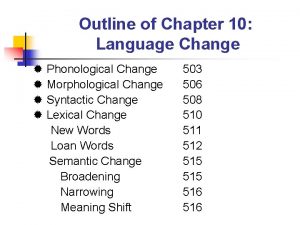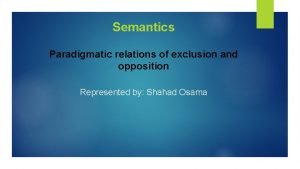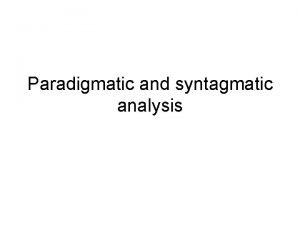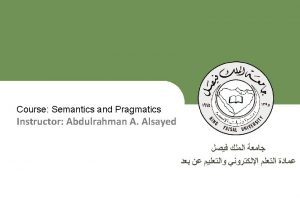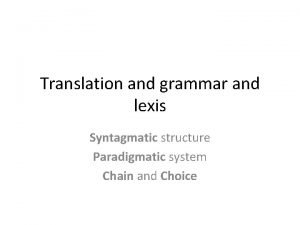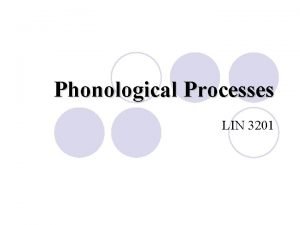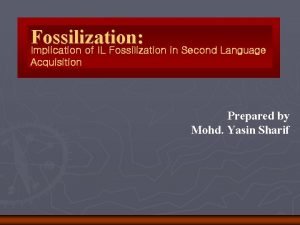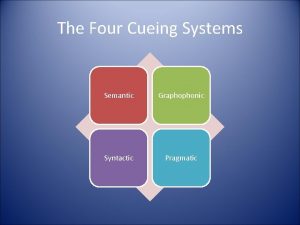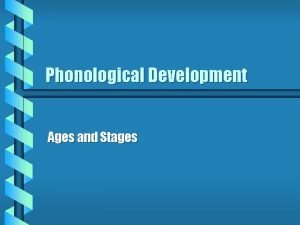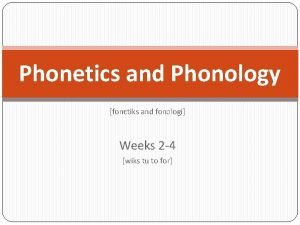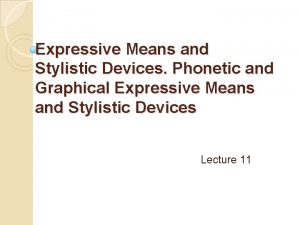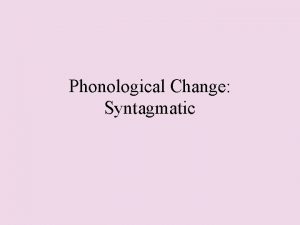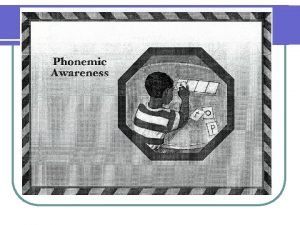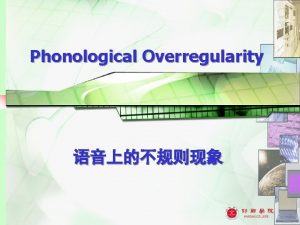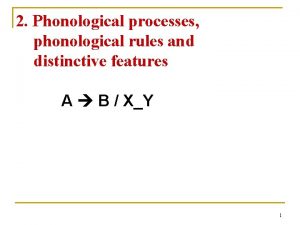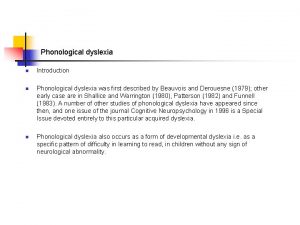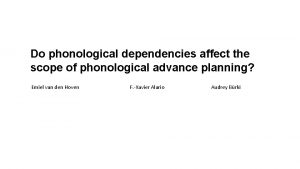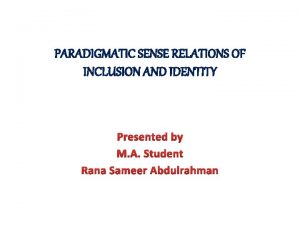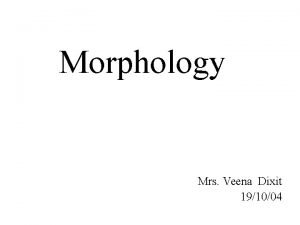Phonological Change Paradigmatic Phonological Change Changes in the




















- Slides: 20

Phonological Change: Paradigmatic

Phonological Change • Changes in the sequence of speech sounds making up the pronunciation of particular words are termed ‘syntagmatic change’. • Change in the phonological system of a language, in contrast, is called paradigmatic change. • Quite commonly phonological systems change as a result of changes in pronunciation, i. e. , as a result of syntagmatic changes. • A fundamental distinction exists between two kinds of phonological change: conditioned and unconditioned changes.

Conditioned vs. Unconditioned Change • An unconditioned change is one that applies to every single occurrence of a particular segment in the language, regardless of its position in a word and regardless of the nature of any neighbouring segments. For example, every single instance of the vowel /i: / in Middle English has changed into the diphthong /ai/ in Modern English. • A conditioned change, in contrast, is one that applies to a particular segment only in certain positions in a word - for example, only intervocalically or only word-finally or only in a stressed syllable etc. Thus, Latin /p t k/ became voiced in Spanish between vowels but remained voiceless in all other positions.

Rephonologization • Rephonologization or rephonemicization is the reorganization of the phonological system of a language. • For example, in Gipuzkoan Basque, the phoneme /j/ has been unexpectedly replaced by /x/, which didn’t exist before, and every word that was formerly pronounced with [j] is now pronounced with [x]: hence jan ‘eat’ and jaun ‘lord’, formerly [j]an and [j]aun, are now [x]an and [x]aun. • The sound /j/ has thus been replaced by /x/, bringing about a rephonologization.

Unconditioned Changes • There are just two cases in which an unconditioned change can affect the number of phonemes in the system. • First, one phoneme may undergo unconditional merger with another one, so that were formerly two different phonemes are combined into a single phoneme. • For example, an ancestral form of Spanish had the two phonemes /b/ and /v/, but these two have merged into a single phoneme in almost all modern varieties of Spanish. The ancient spelling distinction is still retained, so that Spaniards write boto, meaning ‘dull’, but voto, meaning ‘vote’, but these words are pronounced identically. This merger has reduced by one the number of phonemes in the language.

Unconditioned Changes • Second, the unconditioned loss of a segment naturally reduces the number of phonemes by one. • When the ancestral forms of French and Spanish lost the /h/ that they formerly had - inherited from Latin - the number of phonemes in their inventory were reduced by one.

Conditioned Changes • Conditioned changes, in most cases, have more complex effects upon the phonological system of a language. • Pre-Old English had a velar plosive /k/, which was pronounced [k] in all positions, although doubtless with a more fronted allophone before a front vowel, just as in modern English key and cold. • At some time this slight palatalization was exaggerated, until /k/ was pronounced as an affricate [tʃ] before /i/ or /e/ or before a diphthong /ea/ or /eo/. Since there was no other [tʃ] in the language, this change again had no phonological consequences: the phoneme /k/ simply had two allophones, [tʃ] before a front vowel and [k] elsewhere.

Conditioned Changes • But then something else happened: the first element of the diphthongs /ea/ and /eo/ was lost after [tʃ]. As a result, the affricate [tʃ], which had formerly occurred only before front vowels, now found itself in some cases followed by a back vowel. In this position it therefore now contrasted with [k]. As a result, [tʃ] was no longer a predictable allophone of /k/: instead, it was itself a phoneme /tʃ/ contrasting with /k/. • Such a development is called loss of the conditioning environment. At one stage the distribution of [k] and [tʃ] was no longer predictable. We call this phonemic split.

Loss of the Conditioning Environment

Phonological Space • Phonological space is the sum of all the different parameters that are available in constructing speech sounds. • There are many dimensions that we can represent by using the concept of a phonological space. • Consider some examples from consonant inventories: the activity of the vocal folds the position of the velum the presence or absence of aspiration affrication the duration of segments.

Phonological Space • Old English had a set of contrasting voiceless and voiced plosives and affricates: /p t k b d g tʃ dʒ/. • But it had only voiceless fricatives: /f θ s ʃ x/. • Most of them had voiced allophones between vowels, but there were no contrasting voiced fricatives. During the Middle English period, the language acquired a new voiced fricative /v/ as a result of borrowings from French. • This new fricative disrupted the symmetry of the system: now there was a voicing contrast in just one position, and the new set of voiced fricatives consisted of /v/ plus a lot of blank spaces.

Phonological Space • English also acquired a second voiced fricative /z/ partly in loans from French and later on /ʒ/. • As a result, the fricative system of late middle English looked like the following: /f θ s/ /v z/ • The absence of /ð/ as a voiced counterpart of /θ/ (because it didn’t occur in French and could not be borrowed from there) meant that the system was not symmetrical. • As a result /θ/ unpredictably changed into /ð/ as in the words these, that, thy, (just as /ð/ changed into /θ/ in the postvocalic position as in the words truth, breath), hence restoring symmetry to the system.


Vowel Space • In the vowel diagram, the figures of phonological space take obvious advantage of the front-back dimension and the top-bottom dimension in the mouth. • These diagrams can be convenient in representing graphically the effect of any phonological change which involves some degree of rephonologization, change in the phoneme system. • These diagrams may at times actually help us to explain why certain changes have occurred.

The Great Vowel Shift • Middle English had a symmetric system of seven long vowels: /i: e: ε: a: ɔ: o: u: /. • These vowels occurred, for example, in the seven words ride /ri: də/, gees ‘geese’ /ge: s/, bead /bε: d/, name /na: mə/, gote ‘goat’ /gɔ: tə/, goos ‘goose’ /go: s/ and doun ‘down’ /du: n/, respectively. • The two high vowels /i: / and /u: / were diphthongized to /əi/ and /əu/, respectively. The two high-mid vowels /e: / and /o: / were raised into the /i: / and /u: / slots. The two low-mid vowels /ε: / and /ɔ: / were raised into the /e: / and /o: / slots. And the low vowel /a: / was raised into the /ε: / slot. • A set of related changes like this one is called a chain shift.

• There are two possible ways in which the GVS might have proceeded. • Drag chain: a chain that starts with the introduction of some holes, such as the result of diphthongization of high vowels, which ‘drag’ other segments into them, thereby creating more holes which in turn drag other segments into them. • Push chain: a chain that starts with a movement of one segment dangerously close to a second one, i. e. , raising of /a: / toward /ε: /, causing that second one to move out of the way and do the same thing to a third segment.

• Now note that the GVS produced a very odd and unbalanced system of long vowels: three front vowels, but only two back vowels, and no low vowel at all, i. e. , no /a: /. • Low vowels are the most vowel-like of all vowels and are virtually universal in languages. • The short /a/ which had remained unaffected by all this activity was lengthened in many varieties in a few words, as in father, thereby providing some new instances of /a: / • /l/ was lost in certain circumstances, in words like calm, palm, half and calf, leading to a long low /a: / in these words. • A preceding short /a/ underwent compensatory lengthening, and hence words like far, mark and dark now have /a: /, so that farther is pronounced just like father.

Phonological Change as Rule Change • In Generative approaches to phonology, most phonological changes are seen essentially as changes in the phonological rules. • At some point in the history of Spanish, all three of the voiceless plosives /p t k/ became voiced to /b d g/ between vowels. • Rule: [−continuant, −friction] = [+voice]/V_____V • Such rule addition is seen as a major pathway of phonological change. • Rule loss or the disappearance of a rule from a language marks an end to the pathway of phonological change.

Phonological Change as Rule Change • An interesting type of rule change is rule simplification. Here a rule simply loses one or more feature specifications. • All varieties of English have undergone a historical change by which a morpheme-final voiced plosive /b/ or /g/ is lost after a nasal. • Hence words like lamb, climb and comb have lost the final /b/ which they formerly had, and words like long, sing and fang have likewise lost the final /g/ which they once had. • However, the morpheme-final cluster /nd/ is unaffected in standard English: words like land, hand, and find retain their final plosive. • Rule: [−continuant, −friction, +voice] = Ø/[+nasal, −coronal] _____+

Phonological Change as Rule Change • In some American accents, however, particularly in the south, final /d/ has been lost after /n/, so that find is pronounced like fine, stand is pronounced like Stan. • Rule: [−continuant, −friction, +voice] = Ø/[+nasal] ______+ • The feature specification [−coronal] has been lost, so that the rule is simpler to write and applies to a wider range of cases. • This shows that the rule was simplified or generalized to all nasal clusters.
 Old english vs modern english
Old english vs modern english Taxonymy
Taxonymy Syntagmatic analysis
Syntagmatic analysis Syntagmatic and paradigmatic nedir
Syntagmatic and paradigmatic nedir Syntagmatic and paradigmatic
Syntagmatic and paradigmatic Paradigmatic chain
Paradigmatic chain Changes in latitudes, changes in attitudes meaning
Changes in latitudes, changes in attitudes meaning What are physical changes
What are physical changes Changes aren't permanent but change is
Changes aren't permanent but change is Psy
Psy Phonological awareness skills from easiest to hardest
Phonological awareness skills from easiest to hardest Ctopp subtests
Ctopp subtests Assimilation rules in phonology
Assimilation rules in phonology Natural classes phonology
Natural classes phonology Phonological fossilization
Phonological fossilization Graphophonic system
Graphophonic system Phonological development stages
Phonological development stages Examples of allophones
Examples of allophones Coronal consonants
Coronal consonants Expressive means and stylistic devices разница
Expressive means and stylistic devices разница Assimilation in phonetics
Assimilation in phonetics
